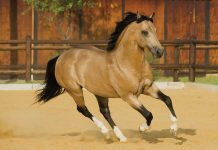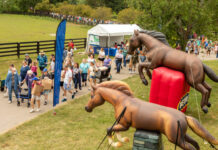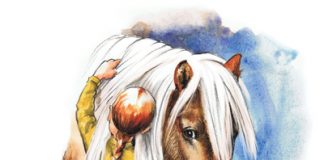Remember how you used steady pressure in the Porcupine Game to get your horse to move? Well, in the Driving Game, you don’t touch him at all! The Driving Game teaches your horse to yield from your signal instead of from physical pressure. With the Driving Game, you can give your horse directions from a distance! Begin by doing the Friendly Game (March/April YR) all over your horse. Do this before every Game.
BACKWARD
From about 10 feet away from your horse’s head, start tapping the Carrot Stick on the ground as though you were blind, and slowly walk toward your horse.
Tap with rhythm, softly at first, like you were playing a drum. Only increase the strength of your tapping if your horse doesn’t move. Walk straight toward him (don’t touch him!), tapping in rhythm. Don’t stop! Your horse has to move!
This is just like how one horse would drive another horse out of the way. He wouldn’t stop until the other horse moved.
Another way to move your horse backward is to place the lead rope over both elbows and take the Carrot Stick in both hands (spread them apart).
Stand about 10 feet away from your horse’s head. Put the Carrot Stick up in front of you and push the air toward your horse’s nose.
Do it slowly at first, then increase the rhythm if your horse doesn’t move backward. There’s no need to rush! (If your horse is “on top of you,” move him away like in the Porcupine Game, then start the Driving Game.) Once your horse gets used to these lessons, try using just your fingers in the air to move him. Spread your fingers apart and flick them at your horse like you are flicking drops of water at him. See if you can get him to move backward with this motion.
Always remember to stop your motion, whether it’s from your hands or the Carrot Stick, when your horse moves (even one step). Then smile at him, rub him, and begin again! None of this will teach a horse to be head shy, because after he’s finished moving backward, ask him to lower his head and play the Friendly Game by rubbing his face.
FRONT END
To move your horse’s front end, stand at the side of your horse between his shoulder and head. With the lead rope in the hand closest to the horse’s shoulder, hold the Carrot Stick in front of you between your two hands and level with your horse’s cheek bone (or as high as you can comfortably reach). Walk slowly but determinedly toward your horse while pushing the air. Start slowly, with rhythm, and only increase the rhythm if your horse doesn’t move.
As soon as he yields (this may be only one step), relax, drop the Carrot Stick downward, smile, and rub your horse with the Carrot Stick. This teaches your horse to read and respond to your body language, not just because there is a stick. By rubbing him with the Carrot Stick, you’re making sure he’s not afraid of it.
Try moving his front end by using just your hands in the same position between the horse’s head and shoulders. Remember, push just the air, and stop and rub him when he responds.
HINDQUARTERS
With the lead rope in thehand closest to the horse’s head, hold the Carrot Stick in the other hand by the handle. Put a determined look on your face, and approach your horse’s hip by moving out in a wide arc (stay wide — you don’t need to get close to his body). Tap the ground with the Carrot Stick (remember: rhythm, rhythm, rhythm).
As he yields his hindquarters, his head should face toward you. Stop, smile and rub his head with your hand. If he doesn’t bring his head to you, but turns it away and tries to leave, shorten your lead rope so his head is tipped toward you. Keep approaching his hip and tapping. The moment he looks at you and turns his hip away, stop, smile and rub him! It’s just that simple! Be sure that each time you play any of the Games there is a responsible adult present.
Next time: The Yo-Yo Game.
This article originally appeared in the Young Rider magazine. Click here to subscribe!





